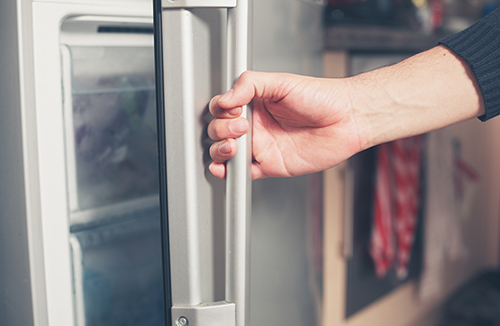Posted on Friday, July 21, 2017
With longer days and no school, summer is often a great opportunity to get things done around the house (especially if you skipped spring cleaning). While it’s common for a To-Do list to include cleaning the fridge out, not many people realize that there is an optimal way to organize the food in their fridge. Below are some tips on how you can keep your groceries fresh with good storage.
THE DOOR
The warmest temperatures. Recommendation: Non-perishables
Lunch, dinner, breakfast, snack time, second breakfast—whatever the reason, most people are in and out of their fridge throughout the day. Consequently, the refrigerator door becomes a high traffic site for warm room temperatures. The USDA confirms these circumstances with their suggestion to store your least-perishable foods in the door, such as condiments. In fact, even though some refrigerators have door compartments for eggs, USDA claims it’s better practice to store a carton of eggs on a shelf.
UPPER SHELVES
Mild and cool temperatures. Recommendation: Ready to eat food
When it comes to organizing the refrigerator shelves, Science 101 reminds us that heat rises while cold air sinks. In other words, foods that do not depend on cold temperatures to remain fresh and safe should usually be stored on upper shelves in the milder temperatures. These foods might include leftovers, dairy products, cooked meats, and other packaged foods. Additionally, storing these foods at the top of the fridge keeps them separate from raw food that should be stored on the lower, colder shelves.
LOWER SHELVES
The coldest temperatures. Recommendation: Meats and poultry
Aside from the science of sinking air, the bottom of the fridge is also where the refrigerator coil is often located, rendering it the coldest place to store groceries. This is usually the best spot to keep highly perishable foods such as raw meat, poultry, and seafood. For best food safety practice, the USDA advises to keep these particular foods secure in the original packaging or a sealed container to prevent cross contamination.
CRISPER
Cold and moist temperatures. Recommendation: Fruits and vegetables
According to ReFED, fruits and vegetables account for approximately 40% of annual food waste in the U.S., which is more than almost all other types of food combined. Part of this waste could be resolved with better storage, which is where crisper drawers come in handy. These drawers are designed to retain moisture, making it the optimal place to store fresh produce (otherwise they dry out).
Most food guides further recommend separating fruits and vegetables if there are two drawers. A natural plant hormone called ethylene can cause sensitive types of produce to become overripe. In other words, storing an apple with cucumbers could cause the cucumbers to ripen too quickly. There are lists that specifically distinguish which produce types ethylene-generative and ethylene-sensitive, but an easy rule of thumb to remember is that most fruits are the former, while most vegetables are the latter.
Remember, the above guidelines are general. Some fridges have different designs so don’t ignore what you’ve noticed about your own fridge. Nevertheless, hopefully these tips will help you maximize the use of your fridge, as well as the life of your groceries!

